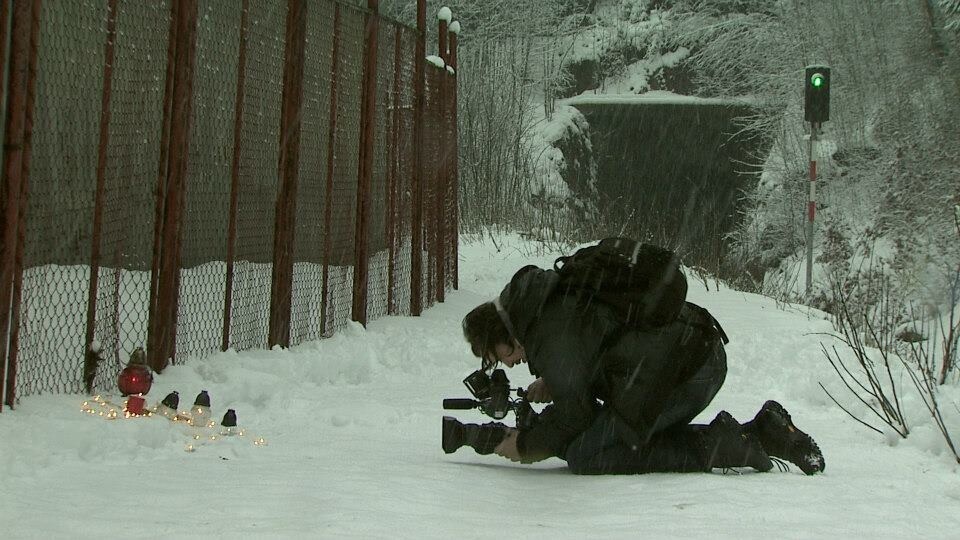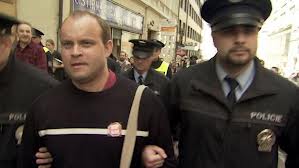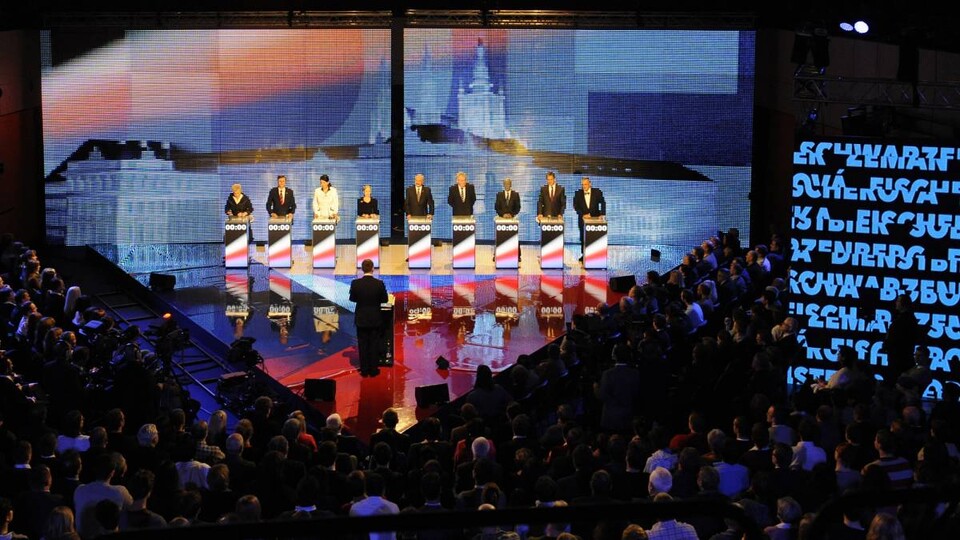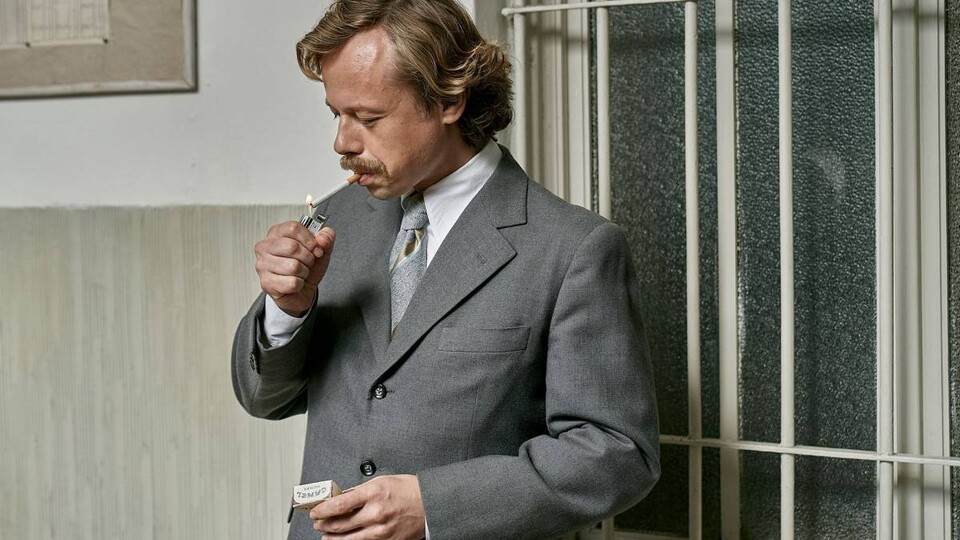Black and white film about racism
We talked to Vít Lesák from the Agency for Social Inclusion, one of the departments of the Human Rights Section at the Office of the Government of the Czech Republic, and to Apolena Rychlíková, a documentary filmmaker and an activist, about the film Life and Death in Tanvald directed by Vít Klusák and Filip Remunda.
What do you think about the filmmaking approach of the authors of Life and Death in Tanvald? Doesn’t it give in to a simplifying anti-racist rhetoric?
Apolena Rychlíková: Czech Journal is a non-stop documentary SOS. When something happens, we jump into the car, drive to the spot and shoot – which, I guess, is in itself rather courageous. When they killed a Roma youth on New Year’s Eve in Tanvald, the first thing that occurred to the authors was to find his family and to follow them – which was a very natural reaction, although the situation did not result in the conflict of the majority and the minority, as they probably expected. As for the message, the majority is a priori blamed for the conflict, which, moreover, resulted in a death. That moment is so powerful that the energy concentrates more around the family than around the offenders.
Vít Lesák: The audience is used to the fact that media provide much less space to the Roma, and if they do, they usually make fun of them. This documentary does the exact opposite, which I find rather refreshing. I would also like to emphasise that when describing one of the events, the authors managed to capture several important aspects from the lives of the poor inhabitants of Tanvald, for example the omnipresent unemployment or segregation. It also shows strong tension in areas where, in few exceptional cases, the majority and the Roma meet. The directors have not made this up. There are only few towns where the situation is as tense as in Tanvald.
Does the film propose any clichés?
Apolena Rychlíková: For me, the portrayed clichés are those of the white majority disliking Gypsies. The woman in front of a hypermarket embodies the effort to define oneself against those who are on a lower rung of the economic ladder. I work from five in the morning, I get up early, toil away and they have no qualms about taking taxis. And now to the price of the taxi: she calculates that it is about five or seven crowns per person, and the bus ticket would be, for example, seventeen. So the taxi is actually a better deal, but so what! Our effort to always control if the others don’t do less or more or don’t do other things is also strongly present and I am glad that Vít Klusák and Filip Remunda show this phenomenon in a rather complex and direct way.
Vít Lesák: They are trying to successfully tear down the deep-rooted cliché that the Roma don’t want to work. It is actually apparent that due to the closing down of factories the unemployment has also affected the majority, and all, not only the Roma, meet at the unemployment office. But I see a sort of a cliché in the platitude of the repeated phrase that each Czech is a racist. And that the filmmakers did not attempt to reconstruct the situation of people living in the town, the real reasons of their frustration and disillusion, that stem from deeper roots than thoughtless racism. I saw it when I took part in the marches in Varnsdorf where I was first called a human-rightist from Prague who does not understand the local situation, but we were gradually able to understand each other. The Office of the Government does not want to favour one party, we rather try to be open to all and to communicate with all. I didn’t see this in the film and I am not sure whether it could be traced in Tanvald and whether the filmmakers at all tried to understand the frustrated inhabitants of the town.
Perhaps, if we did not focus on whether the film is a true image of reality, but approached it, only for a moment, as a scripted drama, it would tell a very simple story of a sad likeable Roma family, disliked by some stupid and unlikeable white people. Can you imagine what impression would the film make on the majority, not particularly people from Tanvald or Prague, but audience in general?
Vít Lesák: People, especially from Tanvald, might not be happy about others making fun of them. However, it depends on where the film is shown. The outcome could be positive in cities and towns where the situation is not as tense as in Tanvald, or perhaps at schools where the screenings would be followed by a discussion.
Apolena Rychlíková: I think that an average viewer will find it difficult to sit through the film, because there is no engaging story to follow, but that is not the fault of Klusák and Remunda, but of the situation itself. I wish that thanks to the directors’ skilful deconstruction of irrationality, people would gain something from the film. In the media, nobody usually asks specifically for the causes of irrationality and xenophobia. It is necessary to make this approach to information a norm, and documentary films can then question the norm also from other perspectives. But for now, we need media to apply the same approach as that taken by the directors, who ask not only what has happened but also why it has happened. On an everyday basis. Otherwise, I think that the audience will resort to an “anti-Gypsy” attitude... unfortunately.
Life and Death in Tanvald by Vít Klusák and Filip Remunda brings up the topic of racism. It seems that there are two contradictory tendencies in the media that focus rather on the individual cases of the conflict of minorities with the majority, which reminds me of soccer, there are two groups of supporters and both of them are, in fact, irrational. Media either adhere to the xenophobic line or to the positively discriminating line. How do Czech media reflect on racism?
Apolena Rychlíková: I think that the problem is more serious, the media discourse is controlled by the neoliberal tendency, a part of which is the dictatorship of maladjustment. We live in a time when the word “Roma” or “Gypsy” has been replaced by the word “maladjusted”, which, as a result, has the same associations as “Roma” or “Gypsy”. The discourse works with yet another word, and that is “old residents”. These two terms are promoted for example by Czech Television, which, as a public service medium, fails to see the problem from a wider perspective. They mostly present only one case through their biased lens, and it always comes out as the conflict of the old residents with the maladjusted. In my opinion, the media are maladjusted.
Vít Lesák: On the one hand, media often have a great impact on how the public perceives the problem itself and encourage latent racism. Unfortunately, some documentaries and films also contribute to this trend. In general, I am not sure whether a documentary that draws attention to racism, exposing it in a similar way as the film about Tanvald, would not cause resentment. The question is whether the exclamation: “look, you are a racist” will work as a catharsis, or a time bomb. If I was to propose a direction for media themselves, it would be to focus more on long-term unemployment or social policy.
|
|
Czech JournalRecent cases and events that are presented from an openly personal filmmaking perspective, often in the form of a polemic and in a surprising context. Czech Journal is a project of the duo of authors Vít Klusák and Filip Remunda and their handwriting is legible in all the films in the series although they have only directed three of the five films. |
Does the elementary media ethics work in the Czech Republic?
Apolena Rychlíková: In my opinion and rather surprisingly, the most racist Czech daily is Právo and Novinky.cz, despite the fact that they are admittedly leftist. They lack a sensitive approach to the problematic issues. There were even cases when they published reports that weren’t true at all. Other media, with the exception of the Referendum daily, do not take a comprehensive approach to the events whatsoever, which results in the fact that readers cannot see a wider context and which further supports irrationality.
Vít Lesák: There have been a few successful legal actions against particular media, which means something. The problem also relates to the fact that the elites also fail to ameliorate the situation, it is not only the responsibility of the media.
Don’t you see also the opposite, slightly “rose-tinted” tendency of the media, as quite problematic? What if they, by their nature, bring the topic to the forefront, but fail to define the problem? For example the poverty business?
Vít Lesák: To me it seems that thanks to the events in Šluknov, the poverty business became a topic.
Apolena Rychlíková: But there is not a systematic approach in that the media would bring the issue back into the game and add the example of executions, unemployment, growing social inequality, etc. In my opinion, the Respekt weekly, for example, fails to follow this noble rhetoric. In the current situation, this is not enough. It is not enough to sit in a café and condemn racism. The Roma, indeed, know how to enjoy life and this romantic image is true – they make grand gestures and have fun even in critical situations. But the only thing Respekt says is that they are beautiful people. It does not pay attention to the implications and the context of the issue. Which is not sufficient.
Would the readers or viewers react to the new rhetoric in a positive way?
Vít Lesák: Media only aggravate the problem and, at the same time, they do not solve it; the improvement in their approach would only be positive, but they primarily have to focus on real-life situations.
Apolena Rychlíková: They simply have to approach the topic in a different way and – said with tongue in cheek – regardless of the consumer.
Can our society, in general, be called racist or, as mentioned by Apolena Rychlíková, “anti-Gypsy” society?
Vít Lesák: I wouldn’t call Czech society an “anti-Gypsy” society but latent racism is generally present. In other areas, there are also problems in relation to other nationalities. Roma people traditionally get attacked. These tendencies are ever increasing. They used to be strong before 1989, but since then, several significant factors have occurred that supported these adverse tendencies. These include, for example, structural unemployment of people who have fallen below the poverty line. Housing segregation has occurred. People don’t meet, don’t know each other, and don’t have friends in other ethnic groups. Many problems stem from the lack of awareness which causes aversion, antipathy and a lack of understanding. And then there is the second wave of socio-economic problems and structural differences between the individual regions. The epicentre of unrest is in the Šluknov region, followed by the Jeseník and Karviná regions, and Břeclav. Their inhabitants experience socio-economic uncertainty, accompanied also with the inability to find a way out. It is a social time bomb that is turning into an ethnic problem.
Český žurnál: Life and Death in Tanvald (Život a smrt v Tanvaldu). Directors Vít Klusák and Filip Remunda, Czech Republic 2013, 52 min.





